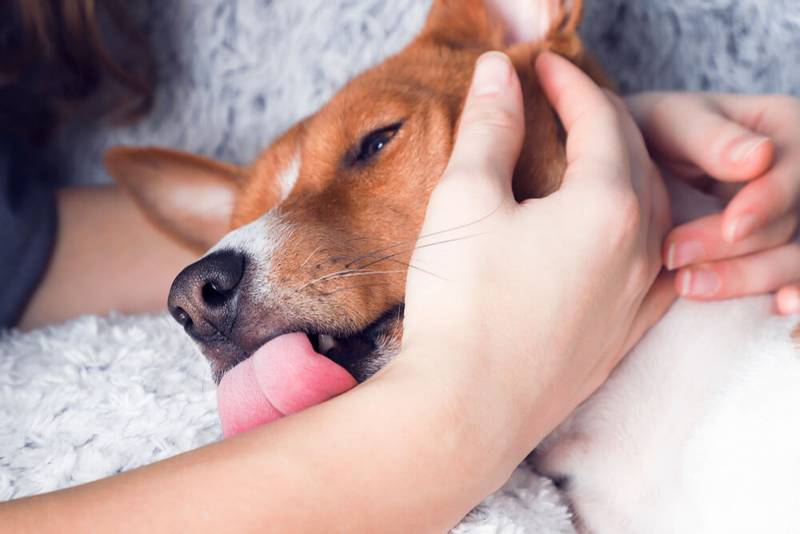In humans, a kiss on the lips or cheek is considered a clear signal of warm feelings. But what happens in the brain of
a dog when it licks a person's face or hands? There is no definite answer to this question, although dog cognition experts have their own theories.
"If we want to boil everything down to one reason, it's communication," says Ellen Furlong, an assistant professor of psychology and neuroscience at Transylvania University in Kentucky, where she studies dog behavior.
"Dogs are very social and well attuned to humans. If a puppy interacts with you, it's often on purpose. But there are many different messages that dogs can convey through licking," she adds.
To understand the intent and meaning of a dog's actions, "I always recommend looking at the situation as a whole," Furlong says. For example, if a familiar dog approaches you vigorously, licking repeatedly and adopting a loose "wiggle" pose, licking your face or hand is likely an expression of greeting or joy.
Similarly, it may be "attempting to make a connection or confirm a connection," suggests Zachary Silver, a professor of psychology at Occidental College, where he directs the Canine Intelligence Lab.
"It's possible that arousal and overstimulation play a role. Dogs lick objects when they are aroused," Silver says. Although he notes that most dogs don't lick everyone indiscriminately, "this behavior is more directed toward people they are familiar with."
Dog instincts
If a dog does not greet all people around him with the same licks, this action is likely to have a social meaning, reinforcing the "pack" relationship. Social hierarchy may also be involved: among dogs, sometimes one animal will lick another as a sign of deference and anticipatory disposition.
According to Furlong, puppies are more likely to lick older dogs. "It's like, 'hey, you're the boss and I know it,'" she says. When humans interact with dogs, this gesture can also carry an aspect of appeasement or submission - depending on the situation. However, some "kisses" may not be so conciliatory.
Licking can indicate that the dog is seeking closeness and affection, or it can indicate the exact opposite: that he needs distance and space.
Furlong states that "distraction licking" is a well-known behavior among canine researchers and trainers that signals that a pet is trying to redirect someone or avoid unwanted attention. Careless "formal" licking of the face or hand, as well as signs of distress such as a tense body, attempts to turn or move away, and noticeable whites of the eyes are all signs of withdrawal rather than greeting.
"People miss a lot of things about their dogs' behavior," she says. "I think we're very good at picking up on signs that a dog is happy, and we miss signs that a dog is stressed or tends to withdraw."
And if you dig even deeper, even licks that seem to express
happiness and calmness can be more nuanced than just a dog's greeting. "
Dog behavior is a complex thing and is often driven by many factors," Furlong says.

.
Photo: petstory.ru
In addition to joyful greeting, there may be a curiosity or even taste component to licking - especially after a dog and its human have met after a long separation. "They will lick to taste something. They may lick to explore. They may lick because you've come home from a run and are very salty," she says.
In
wolves, the wild ancestors of pets, pups often lick the face of the wolf when she returns to the den begging for food. Some canine cognition researchers, such as
Alexandra Horowitz, a professor of psychology at Barnard College, interpret pet dog licking through the same instinctual prism.
"Licking your dog when you come home is an absolute welcome, they're happy to see you, but it's also a little request that you give them what you just ate," Horowitz explains. Even if owners don't share their lunch with their furry friends, dogs enjoy licking them.
First, there is the unintentionally reinforcing feedback in the form of joyful exclamations and stroking that fervent "dog kisses" usually elicit in humans. Attention may be just what the dog is looking for.
Second, another bonus for dogs: licking relieves stress. According to Furlong, dogs repeatedly lick surfaces (or their own paws) to calm down when they're not feeling well, a behavior akin to licking wounds in animals.
A study of dog behavior
At least one 2014 study found that licking, along with other "affiliative behaviors," increases dogs' levels of oxytocin, a hormone associated with social bonding and positive
emotions. Some online resources also claim that licking releases endorphins such as dopamine in dogs' brains, activating the classic neural reward system.
"The exact reasons why dogs lick, lick, and lick, we don't know," Silver says, "because the issue has not been well studied."
"To get a definitive answer or rule out one of the above hypotheses, researchers must conduct empirical experiments in which we see exactly when dogs lick people and in what context," he explains. "In place of the final explanations, we have 'educated guesses'."
However, Silver's research has shown that dogs are deeply attached to their owners and understand subtle social cues. An August 2023 study co-authored by Silver found that dogs are friendlier to strangers who help their owners than to those who don't.
"Dogs do follow what the main people in their lives are doing .... They may be a little more sensitive to social relationships than we previously thought," he says. "If dogs are attentive enough to observe our interactions with people and change their behavior accordingly, then we can be sure that their 'kisses' cannot be left unattended."